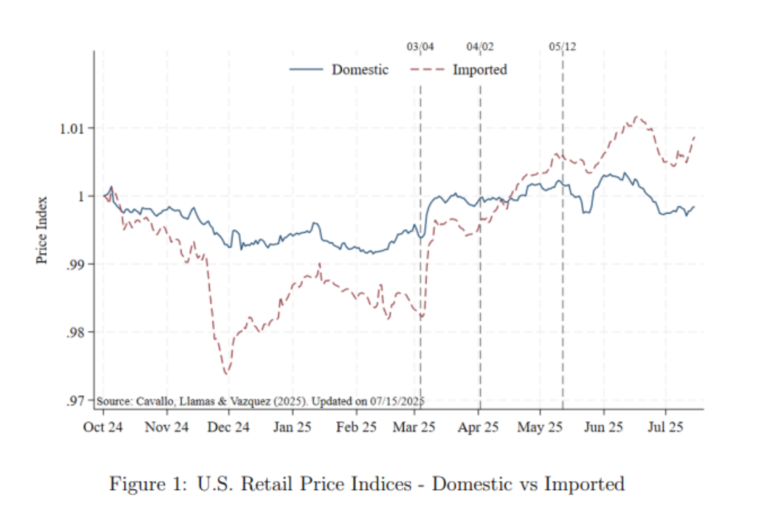Consumer inflation data has yet to reveal any major cost effects of President Donald Trump’s trade policies, leading many to downgrade their predictions of a tariff-induced price spiral in the near future.
But a working paper, entitled “Tracking the Short-Run Price Impact of U.S. Tariffs,” has charted those that the administration’s trade policies have already affected. One of its authors told Newsweek that the impacts, though delayed for now, may begin to significantly impact household budgets later this year.
Newsweek reached out to the Commerce Department and the Council of Economic Advisers via email outside of regular hours for comment.
Why It Matters
The so far muted impact of tariffs on inflation and consumer spending has puzzled certain economists and led political commentators, notably talk show host Bill Maher, to recant their previous criticisms of the president’s economic strategies.
Citing this fact, and the over $100 billion in tax revenue tariffs have accrued, the administration has declared these to be both harmless and a resounding success for the United States economy and its global trade leverage.
However, many experts still caution that the full effects of tariffs will be gradual rather than immediate. Due to a range of interrelated factors—inventory buffers, supply chain adjustments and amendments to announced or threatened duties—they argue that the costs to the American consumer will surface more clearly over time.
What To Know
The paper was authored by Alberto Cavallo of Harvard University, alongside Paola Llamas and Franco Vazquez of Universidad de San Andrés. As shown on the chart below, based on data from the four largest retailers in the U.S., the trio found that the price of imported goods has risen sharply since February. Domestic goods also saw an increase, albeit “more gradual and steady,” which the authors said was due to the reliance of even U.S.-made products on imported components subject to new tariffs.

Albert Cavallo, Paola Llamas, Franco Vazquez
“We observed rapid price responses to trade war and tariff-related news, with average price increases of about 3 percent for imported products since February,” said Alberto Cavallo, a professor of Business Administration at Harvard Business School. “These increases were largely driven by goods from China, particularly in categories such as household goods, furniture, and electronics.”
However, Cavallo told Newsweek that the retail price impacts have so far remained modest when compared with the actual size of the tariffs that were announced over this period. Despite confusing some, Cavallo said this is in line with trends observed during the U.S.-China trade war in 2018-2019, when “prices at the border rose quickly, but pass-through to retail prices was slow and uneven.”
“A similar dynamic appears to be unfolding now,” he said. “U.S. firms are experiencing higher import costs, as suggested by stable or rising import prices, but have not yet passed most of these increases on to consumers.”
The researchers identified several reasons why higher import costs may not have yet translated into higher prices. These include retailers “front-running” or stocking up on inventory ahead of a scheduled tariff hike, the uncertainty surrounding the duration and level of the tariffs that have been subject to constant revision and negotiation, as well as the potentially disastrous “consumer backlash” companies could face if they immediately raised prices to mitigate higher import costs.
“The high level of uncertainty is likely leading firms to delay price adjustments. Overall, we expect the passthrough to retail prices to be gradual and uneven,” Cavallo said, adding that firms are likely to pass on costs to consumers “gradually over time, which means that the inflation rate can be higher for several months.”
What People Are Saying
White House economic adviser Stephen Miran, earlier this month on Fox News: “What we did is we looked at every category in the inflation index…and what we find is…that imported goods are actually getting cheaper.”
Alberto Cavallo, Thomas S. Murphy Professor of Business Administration at Harvard Business School, told Newsweek: “As the graph shows, each time there was news suggesting rising trade tensions, prices tended to increase. When the news pointed to easing tensions (e.g., with the China pause), prices generally stabilized or declined. So I do expect announcements about trade deals to continue influencing prices. Whether that accelerates passthrough to consumers will depend on how high and how long-lasting the tariffs are expected to be.”
What Happens Next
As Cavallo noted, trade deals recently signed and the prospect of a more fully-fledged agreement with China could lessen the overall impact of tariffs on imported goods prices.
However, alongside these negotiations, Trump has continued to threaten higher tariffs on countries such as Brazil, while also stating that the global baseline rate on countries unable to secure a deal could rise to between 15 and 20 percent.


